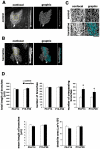Remodeling of monoplanar Purkinje cell dendrites during cerebellar circuit formation
- PMID: 21655286
- PMCID: PMC3105010
- DOI: 10.1371/journal.pone.0020108
Remodeling of monoplanar Purkinje cell dendrites during cerebellar circuit formation
Abstract
Dendrite arborization patterns are critical determinants of neuronal connectivity and integration. Planar and highly branched dendrites of the cerebellar Purkinje cell receive specific topographical projections from two major afferent pathways; a single climbing fiber axon from the inferior olive that extend along Purkinje dendrites, and parallel fiber axons of granule cells that contact vertically to the plane of dendrites. It has been believed that murine Purkinje cell dendrites extend in a single parasagittal plane in the molecular layer after the cell polarity is determined during the early postnatal development. By three-dimensional confocal analysis of growing Purkinje cells, we observed that mouse Purkinje cells underwent dynamic dendritic remodeling during circuit maturation in the third postnatal week. After dendrites were polarized and flattened in the early second postnatal week, dendritic arbors gradually expanded in multiple sagittal planes in the molecular layer by intensive growth and branching by the third postnatal week. Dendrites then became confined to a single plane in the fourth postnatal week. Multiplanar Purkinje cells in the third week were often associated by ectopic climbing fibers innervating nearby Purkinje cells in distinct sagittal planes. The mature monoplanar arborization was disrupted in mutant mice with abnormal Purkinje cell connectivity and motor discoordination. The dendrite remodeling was also impaired by pharmacological disruption of normal afferent activity during the second or third postnatal week. Our results suggest that the monoplanar arborization of Purkinje cells is coupled with functional development of the cerebellar circuitry.
Conflict of interest statement
Figures






References
-
- Mainen ZF, Sejnowski TJ. Influence of dendritic structure on firing pattern in model neocortical neurons. Nature. 1996;382:363–366. - PubMed
-
- Stuart G, Spruston N, Hausser M. Oxford: Oxford University Press; 2007. Dendrites.
-
- Wei DS, Mei YA, Bagal A, Kao JP, Thompson SM, et al. Compartmentalized and binary behavior of terminal dendrites in hippocampal pyramidal neurons. Science. 2001;293:2272–2275. - PubMed
-
- Kaufmann WE, Moser HW. Dendritic anomalies in disorders associated with mental retardation. Cereb Cortex. 2000;10:981–991. - PubMed
-
- Parrish JZ, Emoto K, Kim MD, Jan YN. Mechanisms that regulate establishment, maintenance, and remodeling of dendritic fields. Annu Rev Neurosci. 2007;30:399–423. - PubMed

